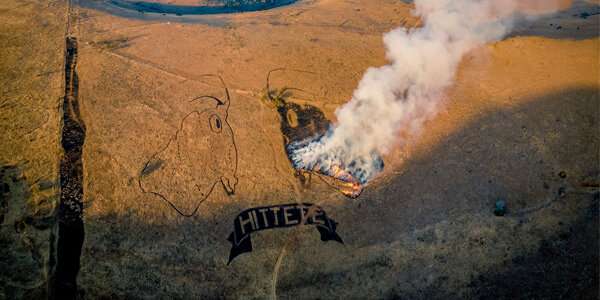How grass dances with fire

There's a long-held myth that Johannesburg is the globe's largest urban forest, resplendent with an annual purple Jacaranda show. But before the planting of these (alien) trees for timber during the Gold Rush in the 19th Century, Johannesburg was a rich and varied grassland—a biome [community of plants and animals] that is one of the least protected in South Africa. Fortunately, the Department of Environmental Affairs prohibits plantation forestry in our grasslands, because of the negative impact it has on water resources and biodiversity.
Sally Archibald, Associate Professor in the School of Animal, Plant and Environmental Sciences (APES) at Wits, explains that grass-dominated environments comprise 40% of Earth's land area and they are critical for the livelihoods of much of the developing world. The Food and Agriculture Organization of the United Nations has made the preservation of such grasslands a priority.
First fires at Frankenwald
Grasslands are Darwinian gold medalists—they have adapted to almost all environmental stressors, including grazing animals and freezing temperatures. Some people might find it hard to understand, but protecting delicate grassy ecosystems requires fire. Controlled burning brings new life and enables grazing animals to benefit from the lush regrowth after fire.
Wits researchers were amongst the first to recognise the benefits of fire in grasslands, back in the 1920s. Professor John Phillips and his successor, Professor Edward Roux, demonstrated to farmers, land managers, and the global research community that the fires across the Highveld grasslands every winter were not unwanted destructive forces, but an essential ecological process. Their experiments took place at the Frankenwald Research Station, north of Alexandra township.
Although there is no longer active research at Frankenwald, grassland research at Wits continues.
Archibald and the APES team are working on projects to understand interactions between fire, drought and herbivory in grasslands across southern Africa. They are doing this with large regional sampling campaigns, as well as greenhouse and field experiments.
"In the Kruger National Park, we have shown that you can use fire to manipulate grass communities to benefit wildebeest grazers, and we are now investigating how this impacts insect, bird, and microbial diversity, as well as tree seedling establishment," says Archibald.
Fanning the flames
The researchers also want to assess how drought tolerance strategies in perennial C4 grasses [warm season grasses, four carbon atoms] affect flammability, and whether changes in grass communities associated with drought can feedback to affect fire regimes. Wits postgraduate student, Londiwe Mokoena, found vast differences in flammability across grass species exposed to drought.
"Each species has a different strategy. Identifying links between drought and fire will help us to manage natural grasslands and to pick appropriate species to grow in different rangeland environments. It will also allow us to understand how fire regimes in natural grasslands might change in the future, as rainfall patterns and grass communities change," says Mokoena.
Provided by Wits University




















